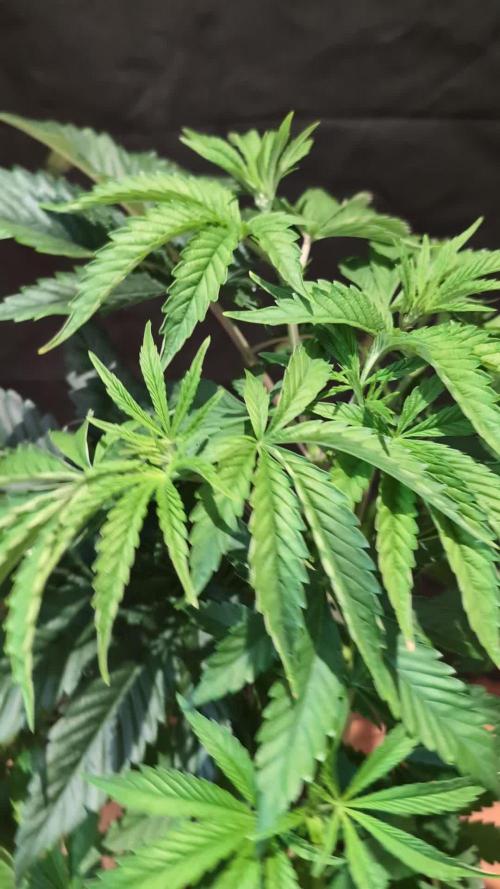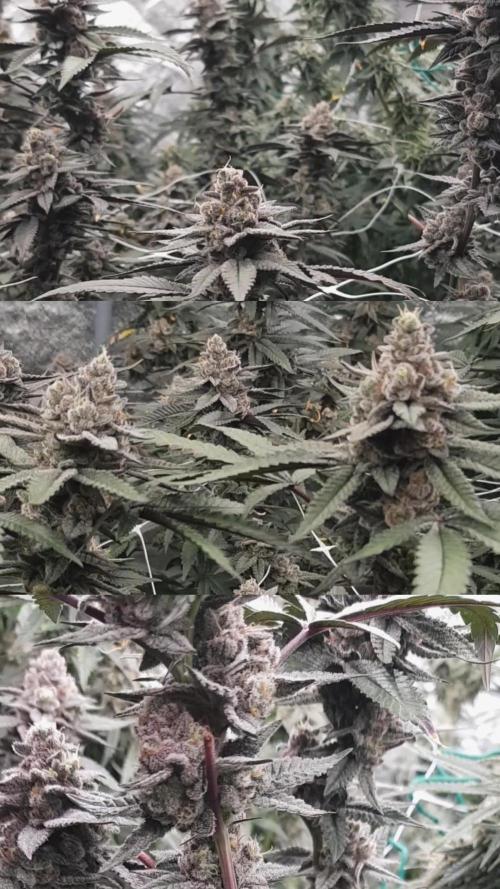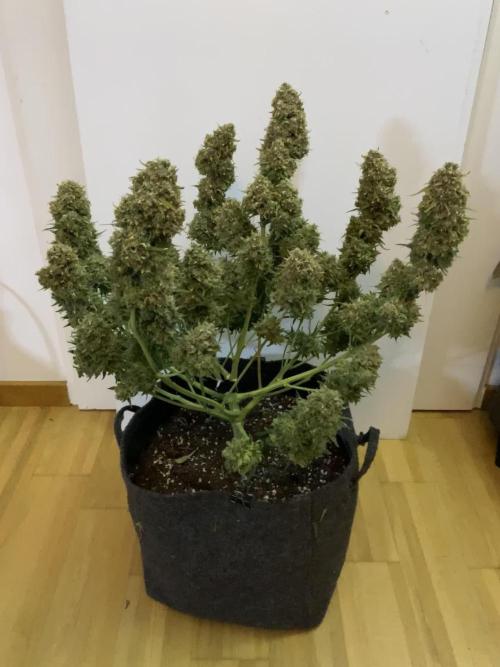The Grow Awards 2026 🏆 

































Likes
96
Share


@gottagrowsometime
Follow
Welcome to my MilkyWay F1 Topped/Untopped Diary sponsored by RQS.
Topped/Untopped Phenos 1/2
Pre Flower Days 12-15, Flower Days 1-4 Days 57-64.
Plants are quick. Didn't put on much height during pre flower. 43 cm for the Topped (pheno 2), and 41 for untopped (pheno 1). The pistils surprisingly are 50/50 amber/white. They're in the fattening stage only a few days. I've added co2 for 12hrs and then they are going under my P1000 for 6hrs. Hoping to see some big buds. They are moving quickly. So, let's see. I've added a 13-14 PK booster from plagron with a few of their other products. With the 12hrs of extra heat and co2, they'll be needing a lot more nutrition.
Diet/Defoliation/Temperature
Was on a Full Plagron natural line and a few of their other products, and I've added a 13/14 PK booster, with fish force and a few others. I done a 10-15% defoliation removing many fan leafs, focusing on the middle to allow better airflow was done after pre flower. And more will be done coming into her next week "10" and light lollipoppoing at the end to clear any possible larf areas was done this wk. So, what's therenow will be brought to harvest, a lot is very far away, so I need to get a blue HID I think to control tight Inter nodes in veg, I'll do this as I gain more experience. 28-29c is maintained for the co2 addition and under the P1000 the temp is brought back down to 26c with no additional co2. And ppfd is lowered to 850 ppfd but its a deep penetrative led light I'll give it that. Actually it carries the highest ppfd into your canopy than any 100w out there, and this is the 2021 version. They've an upgrade. Much respect to Vipar, this light and the Spiderfarmer have been my veg lights the past Yr, and this yr I've used these both and they've produced some quality bud. The cbg is done fully under them and the plant is amazing.
Diet,
Shes on the Full Plagron Natural line, soil and all. "Pro mix" with mega worms to add later. With PK, green sensation, fish force, power roots, vita race, "dummies sent me 2x of these instead of Start" Silic Rock, Pure Zym Sugar Royal. And Terpinator. "Power Roots has been pult, its time recommended by plagron. The roots are plenty and they drink close to 1L of fluids a day. Normally I don't like given so much stuff. But all are different, (expect Terpinator and SR they've the same purpose but its only 1 feed of the Terpinator a wk, by itself 370ppm 6.1ph 15.5c temp..
Co2
Co2 is maintained at 1000-1300ppm for 12hrs. And then when they go back under my p1000 they get ambient co2 levels 675ppm. The co2 is been ate at 350ppm every hr. Mind you most of these girls aren't hitting a high ppfd that's needed to convert into sugars. I've shuffled my 3 fans. 2 fans 1 on the top left blowing above canopy and 1 on the other side. A small one is at the bottom that keeps the heavy co2 off the ground. And my moving my fans, the co2 went from 1000 to 1300 shows, right air-flow is paramount. Thankfully I've a sensor that reads every second and is so sensitive it allows you to move your fans and shows how much longer co2 lasts if kept at an level with the foliage..
WARNING: Co2, is no joke. You can die from inproper use. I fully advise if anything you get a top sensor at least to known your levels and then you can jerry rig whatever. If not using a full kit. I highly urge to have it only in use while you're there to monitor it. No way should it be left on. As co2 is heavy it'll flow down your stairs and your beloved pets will be the 1st to suffer. It doesn't take a lot of gas even from a 1L bottle to fill a 12x12M room to 500ppm.. mine does 3x1L bursts every hr at 0.00001L a burst.
Thanks to my rep James's for the seeds & merch. The rolling tray is constant use. My bird sings its praises. The grinder, possibly the best out for grinding. Goes through wet bud like dry. It grinds it that well. When I'm trying the get a small of her tetpine profile.
COUPONS
Spider-Farmer "ggst" EU (for now) 3%
Mars-Hydro "ggs" WW 3%
Zamneisa "GROWITGD" 20%
Likes
15
Share


@Messypies
Follow
Buds are now looking ripe. The trichomes are mostly milky and senesance has set in nicely.
Pushing until i start seeing 1 or 2 Amber's and then will induce 48hours of darkness to attempt to increase thc production before harvest
Likes
3
Share


@GoodTimesOrganics
Follow
Welcome Back!💚
Nach der vierten Woche entwickelt sich die Peach Frosting im Vergleich zu den anderen Pflanzen etwas langsamer, wobei ich die abzeichnunh der Seitentriebe sehr schön finde.
Die Pflanze wurde letzte Woche noch getoppt und entwickelt aktuell ein homogener aussehendes Wuchsbild.
Ich lasse sie jedoch noch etwas im Wachstum, da sie ruhig nochmal an höhe und Breite gewinnen darf.
Die Umgebungsgegebenheiten sind weiterhin optimal:
—————
🌞 Temp: 24°C bis 26°C
🌚 Temp: 18°C bis 19°C
💨 RH: 68%
VPD: 0,7 kPa👍
—————
Grüne Grüße 🥦
Likes
8
Share


@Australianbuds
Follow
Start week 6! Looking nice and starting to fatten out! Can’t wait for harvest time! PATIENCE! Very happy so far with how they are all doing!
Likes
50
Share


@GERGrowDesigns
Follow
Dear Growers, Welcome to my Dutch Passion Diaries Competition 2025 entry!
For this competition, I’ve chosen the Indoor Feminized strain: Orange Bud 2.0
Media from Week 15 or Flower week 6-7 After Moving into the New Tent for the flower weeks. Stage.
Here’s what I’m working with for the Final Tent after Moving for the Flower time in the Future :
• 🌱 Tent: 220x150x150
• 🧑🌾 Breeder Company: Dutch Passion
• 💧 Humidity Range: 50
• ⏳ Flowering Time: 8W-10W
• Strain Info: 20-25%THC, Sativa
• 🌡️ Temperature: 26
• 🍵 Pot Size: 0.5l
• Nutrient Brand: Narcos
• ⚡ Lights : 720W x 2
Dimmed to 400w Each at the Moment. Because of Heatwave ⭐
A huge thank you to Dutch Passion for allowing me to be a part of this amazing competition and for supporting the grower community worldwide! Your genetics and passion speak for themselves!
Curious to try these strains for yourself?
You can check them out and support me at the same time through my personal link:
https://dutch-passion.com/?a_aid=GGD
I would truly appreciate every bit of feedback, help, questions, or discussions – and of course, your likes and interactions mean the world to me as I try to stand out in this exciting competition!
Let’s grow together – and don’t forget to stop by again to see the latest updates!
Happy growing!
Stay lifted and stay curious!
Peace & Buds!
Likes
14
Share


@Mr_nugs_lover_David
Follow
This lady has been Transplanted on day 39 since she was planted (may 10th) and I've prepared the 15L pot with the complete line of biotabs using 2 spoons of startrex for every 5L, sprinkled a couple of grams of mycotrex on the transplant hole before putting the plant and then I added 3 slow release tabs one biotab for every 5L of soil, so that's why in this case I added 3, after the Transplant was done I immediately watered the plant with 1ml/L of orgatrex and 1g/L of bactrex, I hope you guys enjoy my work this season!!
Likes
44
Share


@RakonGrow
Follow
Note :
+ jegliches Zubehör wird in der GermniationsWoche aufgelistet . Zeitraffer Videos folgen immer nachträglich.
+ videos werden so geschnitten das nur ein geschlossenes Zelt erscheint , ergo Fehlen paar reale Minuten (ca 1 Std) .
Sanlight Tageslichtzyklus in Lebenswoche 6 :
+ 200PPFD - 1h - 750PPFD - 16h - 750PPFD - 1h - 200PPFD = DLI 46.60
+ + Formel : DLI = PPFD * h * 0.0036
+ + in LebensWoche 6 ist der Max-DLI ohne CO² : 45.0
Dazu kann man sich gerne die Zeitraffer angucken . Die Pflänzchen brauchen schon Ihre Zeit auf touren zu kommen . Ergo ist Sonnenaufgang und Untergang reines Stromsparen .
Day 36:
+ 2Liter Flaschenwasser
+ + Dünger für Büte
+ + + Canna Terrar Flores (Achtung wirkt wie PH-)
+ + + Canna Boost
+ + + Cannazym
+ + + Canna Rhizotonic
+ Final : PH 6.2
Nach dem die Mangelerscheinungen wie gewünscht aufgetreten sind, gehts jetzt mit Blütedünger weiter . Sie hat sich prächtig in die neue Umgebung eingelebt. Wetter werte sind hier Super , also ist auch im Zelt super Stimmung :))
Videos folgen in den Tagen .
Day 37:
Sie wächst gerade noch paar Zentimeter :)) Blühten werden mehr .
Day 38 :
Und wieder das Licht etwas höher händen , den Sie wächst noch immer !!!
Day 39 :
+ 2Liter Flaschenwasser
+ + Dünger für Blühte
+ + + Canna Terrar Flores (Achtung wirkt wie PH-)
+ + + Canna Boost
+ + + Cannazym
+ + + Canna Rhizotonic
+ + + Greenhouse Feeding BioEnhancer als PH+
+ Final : PH 5.5 (das Urgesteinsmehl zieht das sowieso auf mindestens PH 6.5)
+ etwas Entlaubung der defiziet Blätter.
Day 40:
Day 41:
+ 2Liter Flaschenwasser
+ + Dünger für Blühte
+ + + Canna Terrar Flores (Achtung wirkt wie PH-)
+ + + Canna Boost
+ + + Cannazym
+ + + Canna Rhizotonic
+ + + Greenhouse Feeding BioEnhancer als PH+
+ Final : PH 5.5 (das Urgesteinsmehl zieht das sowieso auf mindestens PH 6.5)
Day 42:
+ 2Liter Flaschenwasser
+ + Dünger für Blühte
+ + + Canna Terrar Flores (Achtung wirkt wie PH-)
+ + + Canna Boost
+ + + Cannazym
+ + + Canna Rhizotonic
+ + + Greenhouse Feeding BioEnhancer als PH+
+ Final : PH 5.6 , Drain PH 6.89
Likes
422
Share


@Crashoverite
Follow
Hi all 🧑🌾
Welcome to my 🍌💜👊 week update.
Hope everyone keeping well and having a good week.
Thank you so much for your support on this bananas journey 💜💚💜💚
I am so happy to see how girls are developing in recent days. It's seems that Athena finally stopped her stretch and hoping that Xena will follow her sister very soon. Buds are gaining weight and size rapidly. Lots of nice colours and tonnes of trichomes on those buds already.
Week 10
Dec 18-24
Dec 18-19
Mainly observation. Xena is still stretching like crazy. both girls are developing beautifully.
Dec 20
First watering for this week. 7.5 ltr beetwen both. Runoffs PH's Athena 6.2 Xena 6.3.
Dec 21
Due to lack of light at lower parts of conopy decided for another selective defoliation, lowered a bit tallest branches with colas dangerously close to light by tieing them to netting. Couple cm will make a huge difference here. Could not clear well at the back wall of the cabinet due to limited access.I'm very happy with final result.
Dec 22-23
Joyful observation of my 🍌💜👊girls development 🧑🌾
Dec 24
All is looking great. It's seems that stretch is finally stopped. Girls looking healthy and happy.
Second watering for this week. 8 ltr beetwen both. Both runoffs PH 6.2.
It's the end of this week.
Happy Xmas everyone 🤶🎄❄️🎁☃️✌️💚🌲🎅🎄
Stay tuned for new week update ✨🍀✨✌️💚
Likes
2
Share


@Drtomb
Follow
Flipped the girls and lowered the screen. Moved the tops to the sections I wanted. Changed the nutes. Buckle up, sit back and subscribe. It'll be a fun journey I promise.
Likes
6
Share


@Krautbauern
Follow
On day 38, we topped the top shoots of the chimera again because she is getting way to gig already. Then, after 40 days in the vegetation phase, we sent them into flowering.
From now on 12/12h Day-nightcycle
We cut some Clones at day 47 because we had to wait until our clonex arrives.
Likes
32
Share


@Ferenc
Follow
Mini group cute 😍 I like art, bonsai cannabis :)
Honestly I had some issues I had to change the soil no choice but all good now they started coming.
Cute little bonsai girls.
Fetrilization continues the same way on Monday, Wednesday and on Saturday with the mix above :)
Likes
3
Share


@The_Lonely_Farmer
Follow
So these girls are sailing into preflowering week now starting this week will be their first week of flower💚
All happy and healthy and have been heavily defoliate and removed any excess branching down lower that isnt receiving light 🌱
The 2 icc are really tall and competitive and the toronjaz shorter yet wider
They will hopefully transition this week happily into flower 🌱
I have 2 icc and 3 toronjaz remaining,
Let's hope they continue too do well.
My light was a little close but have now sorted that and they will now be flipped too 12/12 light shcedule 🌱
Aptus nutrients have really helped these girls and I think they also myself are so happy too use these nutrients they really are effective and simple too use 👊💪
Stay blessed 💚
Likes
3
Share


@Spankstheedanks
Follow
sorry I missed a week😪 been very busy plus its been very hot this past two weeks but she seems to love the sun and the heat regardless that fact. she really hasn't growth up much but with the fimming lots of new growth training with a tomato cage n its really helping out as y I u guys and gals can see thank you for stopping by 🙏 stay tuned let's see how bushy she gets by next week feeding day is tomorrow she always loves that happy growing everyone 🌱🙏
Likes
4
Share


@GTools
Follow
Finally it was time to cur them down. There is a nice layer of glassy trichomes and the plants have dense buds.
I am expecting a decent harvest outcom.
Updates will follow drying and curing proceeds
Likes
2
Share


@magicgarden
Follow
petite carence avec la hulk berry de RQS carence en fer apparemment du a un PH un peut élever du terreau j'essaie de rectifier ce problème mais pas facile si non sur les trois autre de chez KANNABIASEED les 3 gorilla king aucun problème ça stretch bien et elles se porte très bien
Likes
80
Share


@Roberts
Follow
Pure Ice cream clone is very top heavy. She fills the whole tent. She has a good strong smell. Looking frosty, and just eating, and drinking everything I throw at her. Cokas are looking frosty, and dense. Thank you Spider Farmer, and Pure Instinto Seeds. 🤜🏻🤛🏻🌱🌱🌱
Thank you grow diaries community for the 👇likes👇, follows, comments, and subscriptions on my YouTube channel👇. ❄️🌱🍻
Happy Growing 🌱🌱🌱
https://youtube.com/channel/UCAhN7yRzWLpcaRHhMIQ7X4g
Likes
22
Share


@J_diaz420
Follow
Muy olorosa genética, me encantó mucho, termino de engordar al 100% los cálices absorbiendo los postilos de las flores y eso para mi es muy importante, muy agradable al fumar con un efecto inmediato apto para el día a mi pensar ya que su efecto se nota mucho pero no es para dejarte tumbado si no que con mucho ánimo en fin muy agradable para conectar tu mente a la música que es algo que me encanta al fumar, en fin muy fácil de cultivar, crece mucho así que procura dar poca vegetación, creo que yo me excedí un poco, y no olvidar alimentar a tiempo ya que beben mucho.
Realmente contento con esta experiencia
Muchas gracias por pasar y felices cultivos!!























